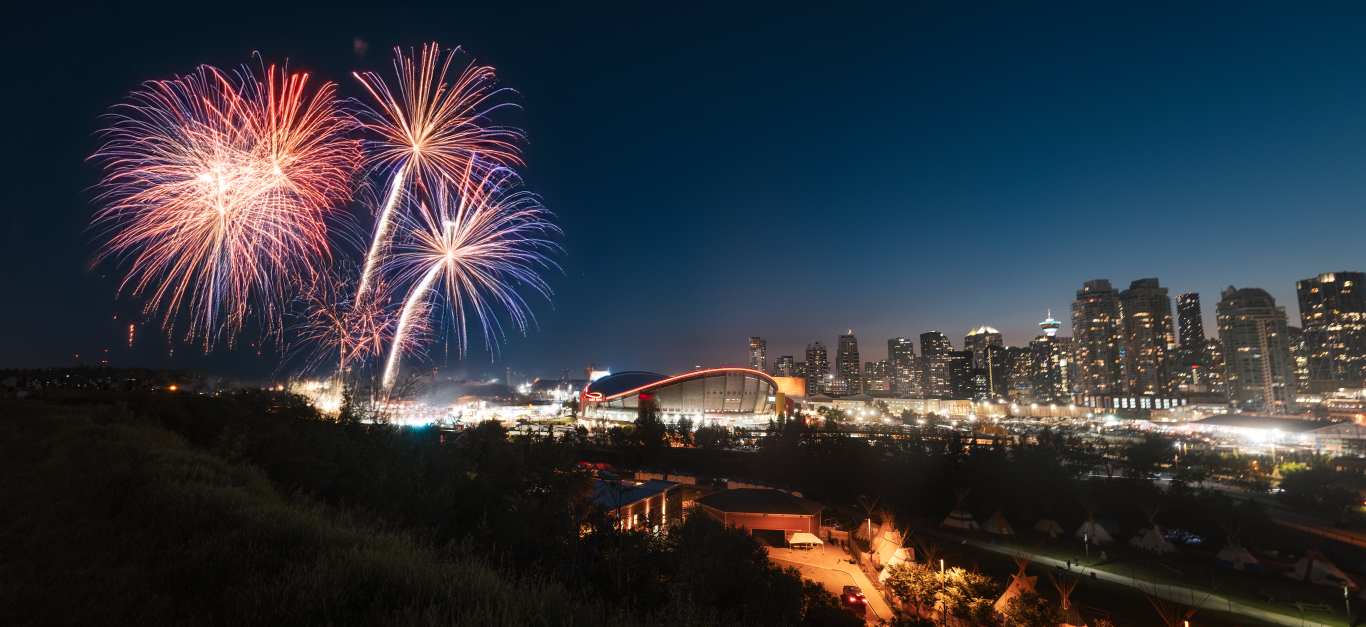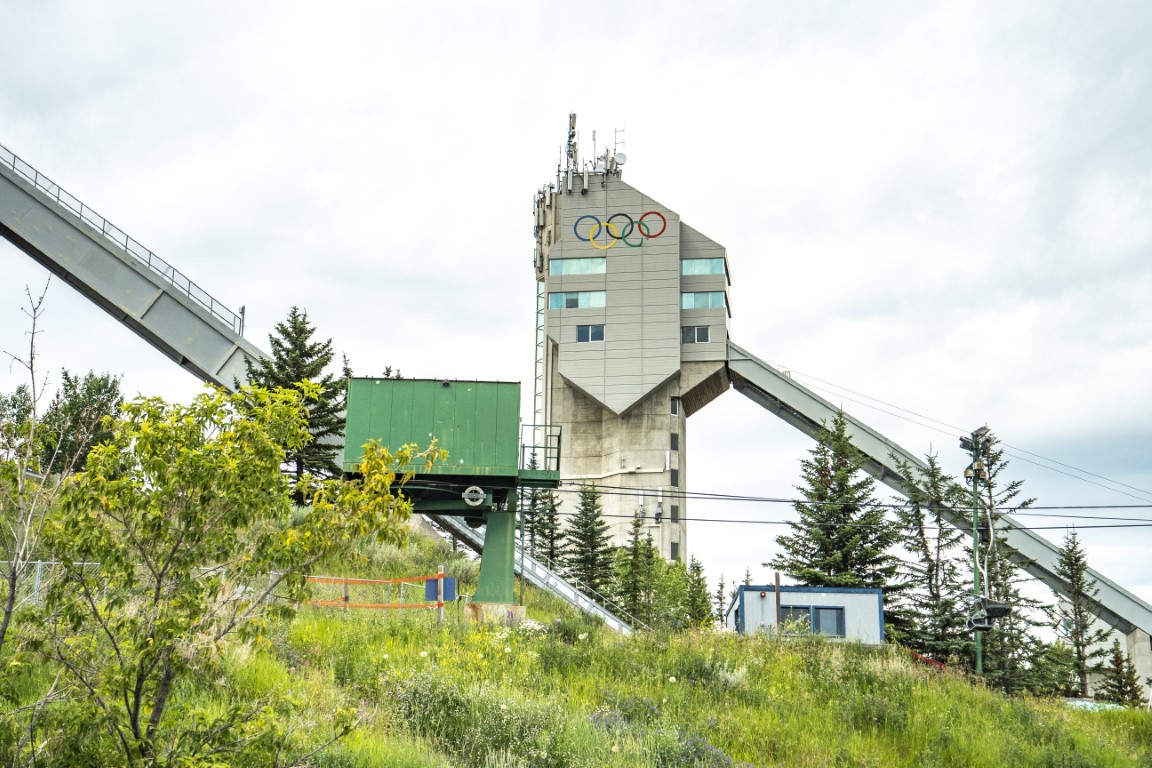Calgary’s Concrete Chronicles: Saddledome
This is the second post in Calgary’s Concrete Chronicles — a blog series exploring the iconic landmarks that have shaped the spirit, skyline, and soul of Calgary. From stadiums to skyscrapers, each post uncovers the stories behind the structures that define our city. We love sharing this history with longtime locals, newcomers, and anyone curious about the character of Calgary’s built environment.
Today, we’re spotlighting one of the most recognizable silhouettes on Calgary’s skyline — The Scotiabank Saddledome. Built in the early 1980s for the 1988 Winter Olympics, this architectural marvel has hosted hockey legends, sold-out concerts, and unforgettable community moments — all under its iconic curved roof.
Use our quick navigation guide below to jump to any part of our Saddledome story: 
- Before the Dome: Calgary’s Search for a Big-League Arena
- Designing the Dome: The Architecture That Defined a Skyline
- The Olympic Legacy: The 1988 Winter Games
- The Flames Era: From Gretzky Rivalries to Cup Glory
- Concerts, Culture, and Community
- Floods, Repairs, and the Future of the Dome
- The Neighbourhood: Victoria Park and the Stampede Grounds
- The Legacy of the Saddledome
- The Future of the Scotiabank Saddledome — What’s Next After Scotia Place Opens
- Demolition & Land Re‑Use
- Mixed Use & “24‑Hour” Activity Hub
- Memorialization & Legacy Space
- Community Sports / Recreation Component
- Smart Urban Integration
- Share Your Saddledome Story
Before the Dome: Calgary’s Search for a Big-League Arena
Before the Saddledome’s famous roofline curved into view, Calgary’s biggest indoor venue was the Stampede Corral — a 1950s-era arena that had served the city well for decades. But by the late 1970s, the Corral was showing its age, and Calgary had ambitions far beyond rodeos and local hockey.
The arrival of the Calgary Flames from Atlanta in 1980 gave that ambition focus. The team needed a modern home — something bold, distinct, and worthy of a growing city eager to prove it belonged on the national and global stage.
Designing the Dome: The Architecture That Defined a Skyline
Completed in 1983 at a cost of $97.7 million, the Saddledome was more than just a hockey rink — it was a statement. Designed by local architects Graham McCourt and Associates, its signature parabolic roof wasn’t just for looks. It was an engineering feat — one of the longest-spanning concrete shell roofs in the world at the time, created to improve sightlines for every seat.
The name “Saddledome” came naturally — a nod to Calgary’s cowboy heritage and the annual Stampede. It instantly became a city symbol, blending the rugged West with modern design in one unforgettable silhouette.
From the outside, the sweeping roof captured the spirit of the prairies; from the inside, it created an acoustic and visual intimacy that made concerts and games electric.
The Olympic Legacy: The 1988 Winter Games
When Calgary won the bid for the 1988 Winter Olympics, the Saddledome became a crown jewel of the Games. It hosted Olympic hockey and figure skating — the stage for legends like Katarina Witt, Brian Boitano, and Wayne Gretzky.
For two unforgettable weeks, the Saddledome wasn’t just a sports arena — it was the world’s living room. Television audiences around the globe saw Calgary’s skyline crowned with that unmistakable curve, forever tying the city’s identity to the Games and its spirit of hospitality.
The Flames Era: From Gretzky Rivalries to Cup Glory
Since 1983, the Saddledome has been home ice for the Calgary Flames. It’s where fans roared during the Battle of Alberta, where Lanny McDonald lifted the Stanley Cup in 1989, and where the red “C of Red” became one of hockey’s most passionate fan traditions.
Generations have grown up under its roof — parents passing on season tickets, kids dreaming of playing beneath the dome lights, and fans filling the air with “Go Flames Go!” from October to April (and sometimes, with luck, beyond).
Concerts, Culture, and Community
Beyond hockey, the Saddledome has been Calgary’s premier stage for entertainment. From U2 and The Rolling Stones to Garth Brooks and Taylor Swift, nearly every major touring act of the last four decades has performed here.
The Dome has also hosted rodeos, charity events, graduations, and even royal visits. Its place in Calgary’s collective memory is as much cultural as it is athletic — a venue where the city gathers to celebrate, sing, and cheer together.
Floods, Repairs, and the Future of the Dome
In June 2013, disaster struck when the Bow and Elbow rivers overflowed, flooding much of Calgary’s downtown — including the Saddledome. Water filled the lower levels up to the eighth row, damaging locker rooms, electrical systems, and seating.
But Calgary’s spirit of resilience shone again. Within months, crews restored the building, and by the start of the 2013–14 NHL season, the Flames were back on the ice.
Today, the Saddledome stands as both a beloved icon and an aging one. Plans are underway for a new event centre in Victoria Park, set to open later this decade. While the new arena promises state-of-the-art facilities, many Calgarians know the Dome’s distinctive roofline will be deeply missed on the skyline.
The Neighbourhood: Victoria Park and the Stampede Grounds
The Saddledome sits within the heart of Calgary’s Victoria Park and Beltline neighbourhoods — where history meets reinvention. Just steps from the Elbow River, the CTrain, and the Stampede Grounds, this district has transformed from industrial yards to a lively hub of restaurants, arenas, and music festivals.
Each July, the Dome becomes part of the Stampede’s pulse, surrounded by midway lights, live music, and the smell of mini donuts drifting through the evening air. Few places capture Calgary’s mix of grit, pride, and hospitality like this corner of the city.
The Legacy of the Saddledome
For more than forty years, the Saddledome has stood as Calgary’s architectural signature — a concrete symbol of optimism, innovation, and western flair. It’s where gold medals were won, Stanley Cups were hoisted, and songs echoed across generations.
As the city looks to the future with plans for a new arena, one truth remains: the Saddledome isn’t just a building. It’s part of Calgary’s story — built in our image, shaped by our ambitions, and remembered for its role in defining who we are.
The Future of the Scotiabank Saddledome — What’s Next After Scotia Place Opens
With the new Scotia Place event centre set to anchor Calgary’s rivers‑district revival, the Saddledome’s next chapter is already being sketched out. Here’s a breakdown of what we predict — and what we hope for.
Demolition & Land Re‑Use
According to the city’s FAQ, once Scotia Place opens the Saddledome will be demolished. Read more about that [here]. That clears a large site in the heart of the Victoria Park/Stampede‑grounds zone. Our prediction: the cleared land becomes a prime infill opportunity — high‑density residential, mixed‑use retail, or maybe innovation‑office space.
Mixed Use & “24‑Hour” Activity Hub
Given the direction for the Culture + Entertainment District, expect the site to shift from event‑only use to a year‑round neighbourhood hub. Imagine: apartments, shops, cafés, perhaps a boutique hotel. The goal: keep the area alive beyond game nights and concerts.
Memorialization & Legacy Space
The Saddledome has a rich story — Olympic venue, Stanley Cup win in ’89, concerts, floods. We predict the site might include a tribute plaza, maybe public art or plaques acknowledging its legacy, preserving the memory even as the building goes. The FAQ says the city is “committed to celebrating its legacy.”
Community Sports / Recreation Component
Even though the new main event centre will be at Scotia Place, there may be a push to retain the site for community‑oriented sports or special‑purpose facilities (e.g., indoor training, recreation centre). A smart move would be a smaller‑scale version of its legacy use, serving neighbourhoods.
Smart Urban Integration
Given the planning around Scotia Place — plazas, connectivity, Indigenous design input — the Saddledome site isn’t likely to be left as vacant space. Instead: integration into Calgary’s densification strategy. We foresee transit‑oriented development, pedestrian‑friendly streetscapes, maybe eco‑redevelopment (green buildings, storm‑water features) given Calgary’s push for sustainability.
The Saddledome’s future will shift from being “the place where Calgary gathers for big shows and big games” to being “a place where Calgary lives, works, and strolls through”. It won’t vanish entirely — its footprint will be re‑tooled for everyday life, not just the big event nights.
Share Your Saddledome Story
Did you see a concert that changed your life? Watch a Flames playoff run you’ll never forget? Maybe you were there in ’89, watching the Flames raise the Stanley Cup — a moment burned into Calgary’s soul.
Tell your story — or better yet, make new memories while you still can.
Because the Saddledome isn’t just concrete and steel — it’s Calgary’s heartbeat, curved against the sky, echoing with decades of roars, cheers, and unforgettable nights.
As we count down the final chapters of this iconic arena, don’t just remember it — live it one more time. This is more than nostalgia. It’s your story, our city, and one last shot to be part of history before the lights dim for good.

Calgary’s Architecture Tells a Story — I Just Help Share It
Every city has a heartbeat — Calgary’s happens to echo through concrete, steel, and skyline silhouettes. The Saddledome isn’t just a building; it’s a symbol of how fast this city learned to dream big. I’ve spent years exploring Calgary’s neighbourhoods, uncovering the layers that make each one unique — and landmarks like this remind us how the past keeps shaping where we’re headed.
If you’re drawn to Calgary’s legacy architecture or want to live closer to the communities where our city’s story began, let’s talk. From heritage charm to modern masterpieces, I’ll help you find a home that reflects the same pride and identity that built this skyline.
Dusko Sremac – Calgary & Area REALTOR® | Team Lead, REPYYC
Cell: 403-988-0033 | Email: dusko@repyyc.com




Leave A Comment